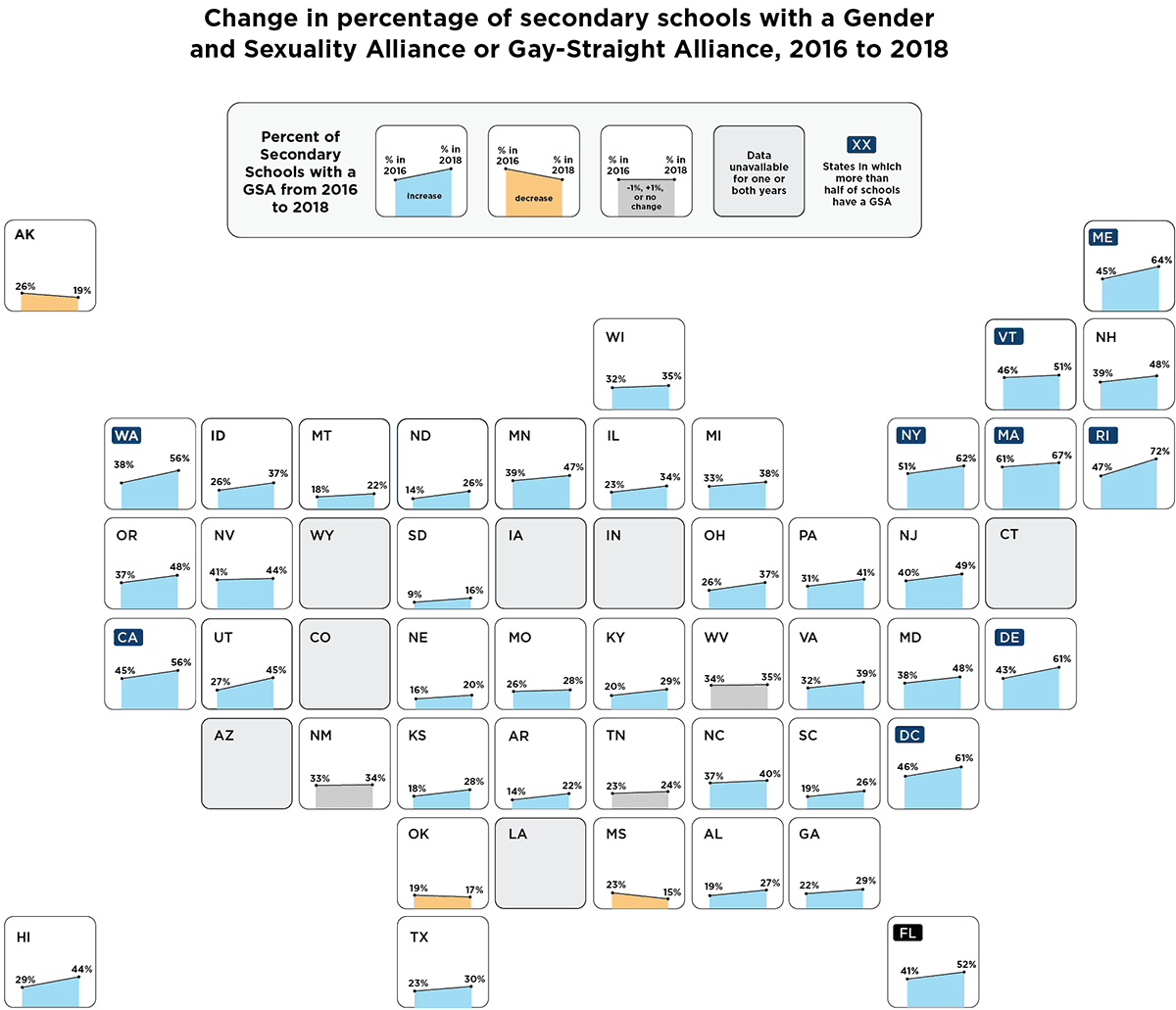Only 9 States and DC Report That More Than Half of Secondary Schools Have a Gender and Sexuality Alliance
Gender and Sexuality Alliances or Gay-Straight Alliances (GSAs) are faculty-sponsored, student-led school clubs in which students can talk, learn about, and educate others on sexual orientation, gender identity, and issues affecting lesbian, gay, bisexual, transgender, queer, and/or questioning (LGBTQ+) youth. A Child Trends analysis of the Centers for Disease Control and Prevention (CDC) School Health Profiles found that—with the exceptions of Alaska, Mississippi, and Oklahoma—every state with both 2016 and 2018 data reported an increase in the percentage of secondary schools that have GSAs (see map below). Despite this progress, only nine states and the District of Columbia (highlighted in dark blue in the map) reported that more than half of their secondary schools had a GSA. Still, this represents an increase from 2016, when only Connecticut, Massachusetts, and New York hit that mark. In 2018, Rhode Island reported the highest percentage of secondary schools (72%) with a GSA, due to a 25-percentage-point increase from 2016 to 2018, the largest increase of any state. Mississippi had the fewest schools with GSAs (15%), an 8-percentage-point decrease from 2016 to 2018 and the largest decrease of any state.

Sources: Centers for Disease Control and Prevention. (2019). School Health Profiles 2018: Characteristics of Health Programs Among Secondary Schools. Centers for Disease Control and Prevention.
Centers for Disease Control and Prevention. (2017). School Health Profiles 2016: Characteristics of Health Programs Among Secondary Schools. Centers for Disease Control and Prevention.
GSAs are consistently found to be effective at promoting a positive school climate and improving academic outcomes for LGBTQ+ youth. While LGBTQ+ youth may experience stigma and discrimination related to their sexual orientation or gender identity—including higher rates of victimization, such as bullying at school and cyberbullying—GSAs can serve as a buffer by providing LGBTQ+ youth with a source of community, a gateway to LGBTQ-friendly resources, and a marker of safety. Moreover, while not all GSAs are perceived as being inclusive of the needs of youth of color, studies show that they are associated with benefits for all students, regardless of sexual orientation or gender identity, and that these benefits can accrue to students who do not participate directly in the GSA.
This school year, GSAs will play a particularly critical role in serving the needs of LGBTQ+ youth—many of whom experienced poorer mental health and more stressful living situations during the COVID-19 pandemic. State education agencies can foster a more supportive environment by acknowledging the importance of GSAs and providing accessible resources and training to Local Education Agencies. Both GLSEN and GSA Network, national organizations dedicated to supporting LGBTQ+ students, have developed a set of resources for GSAs.
This blog updates our June 2019 analysis with the most recent data, from 2018.
Series
- Only 17 States and DC Report LGBTQ-Inclusive Sex Ed Curricula in at Least Half of Schools, Despite Recent Increases
- Schools Can Reduce Barriers to Mental Health Access by Ensuring That Services Are Supportive of LGBTQ Youth
- State-level Data Show Schools Can Facilitate LGBTQ Students’ Access to Relevant Physical Health Services
© Copyright 2024 ChildTrendsPrivacy Statement
Newsletter SignupLinkedInThreadsYouTube